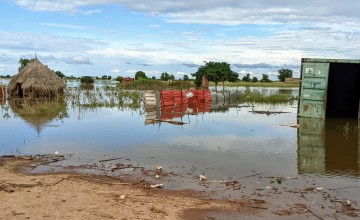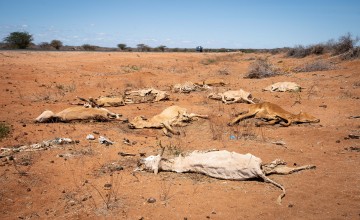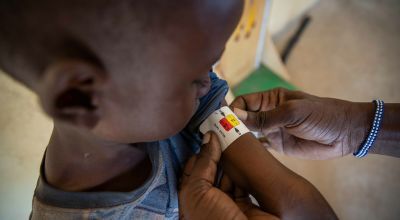
Knowledge Hub
We are bearing witness to the catastrophic effects of climate change across the world, particularly in East Africa. Currently, over 23 million people are contending with dangerous levels of hunger in Ethiopia, Kenya, Somalia and South Sudan, a crisis that is largely compounded by climate change.
Here are five facts to know about how climate change is changing East Africa.
Temperatures are rising

Temperatures in Africa are rising faster in comparison than other regions. Although Africa’s population as a whole only produces 4% of global greenhouse gas emissions (in comparison to the richest 10% of the world who produce over half), Africa shoulders the burden of climate change.
East Africa has been particularly affected by the greenhouse effect. For example, since 1860, Addis Ababa in Ethiopia has warmed by 2.2 degrees Celsius, while temperatures in Nairobi, Kenya have increased by 1.9 degrees. By 2100, the average temperatures in East Africa are predicted to rise to between 1.8 and 4.3 degrees higher than the average temperature in the 1990s.
Rising temperatures, as we’ll further explain, have negative effects on weather patterns, agriculture and biodiversity.
Climate change is leading to more extreme weather in East Africa

As the global mean temperature continues to rise, extreme weather events are being intensified by climate change.
The Fifth Assessment Report in 2014 from the Intergovernmental Panel on Climate Change (IPCC) provided evidence that the risks associated with extreme weather patterns will increase as global warming worsens. Additionally, scientists have published over 150 attribution studies connecting extreme weather and man-made climate change.
This volatility of climate systems is negatively affecting East Africa. As the temperature rises, extreme heat events are becoming more protracted, common and deadly. This poses a threat to people and biodiversity living in both rural and urban environments.
Plus, the climate crisis is creating a rapid heating of the waters in the Indian Ocean, which is intensifying the cyclone seasons. Communities on the East African coast and as far south and inland as Zimbabwe, are having to contend with more frequent and catastrophic cyclones.
Plagues of locusts are worsening

East Africa has been ravaged by extremely damaging locust plagues in recent years. From 2020 to 2021, East Africa experienced one of its worst locust plague in decades, with the insects destroying crops and plants across Ethiopia, Somalia and Kenya. The type of locust is called the desert locust, which has been dubbed by the Food and Agriculture Organisation of the United Nations as the most “destructive migratory pest in the world.”
- In one day, a single square kilometre swarm of locusts can consume as much food as 35,000 people.
- One square kilometre of a swarm can contain up to 80 million adult locusts.
Desert locusts generally are confined to the semi-arid and arid deserts of Africa and Asia that receive less than 200mm of rainfall annually. Wet weather and warmer climates increase the population of locusts and unfortunately, in May and October 2018, two devastating cyclones hit East Africa. The heavy rainfall that accompanied these cyclones created moist conditions that the pests find favourable to breed and their population increased up to 400% above normal during this period. With the rise in global temperature, sea waters are being warmed which exasperates the rainfall caused by cyclones, which in turn leads to more locusts.
Rainfall is erratic and the volatility of flooding has increased

To put it bluntly, climate change has made the frequency and intensity of rainfall too inconsistent across East Africa. Currently, significant parts of East Africa are experiencing one of the worst droughts in recent years due to consistently below average rainy seasons. This is in stark contrast to the 2019 October – December rains, which were one of the wettest on record, with many places experiencing double the rainfall which in turn caused severe flooding and landslides.
Much of the tropical weather patterns in the region are dictated by La Niña. La Niña is a climate pattern that refers to the regular changes to tropical atmospheric circulation that affects wind pressure and rainfall. Scientific evidence suggests that due to climate change we will start to see drier La Niñas in the future, resulting in less reliability of rains during this period.
On the one hand you have drier conditions, but during the same period, in other parts of East Africa, such as Uganda, the water levels of Lake Victoria reached their highest points since records began, displacing thousands of people.
Agriculture and biodiversity are being wiped out

Agriculture is a crucial part of East Africa’s economy, and man-made climate change is placing pressure on an already fragile region.
Heatwaves threaten killing entire livestock and reducing biodiversity, while flooding increases the risk of disease for both humans and animals. Rainfall variability may lead to declines in staple crops such as maize and beans in over 50 to 70% of the entire region. Around 80% of people in the region live in rural areas and are heavily dependent on farming which hurts jobs and livelihoods.
For example, as a result of recent droughts, in Somalia 3 million livestock have died. Many people in places like Marsabit, Kenya, have suffered losses of all their livestock and are forced to survive on barely nutritious bush fruit.
Our response
Concern Worldwide has been supporting communities during this difficult period by delivering nutritional assistance and by improving water accessibility.
We have also been vaccinating livestock against diseases and providing emergency cash transfers to affected communities to help people buy nutritious food.





